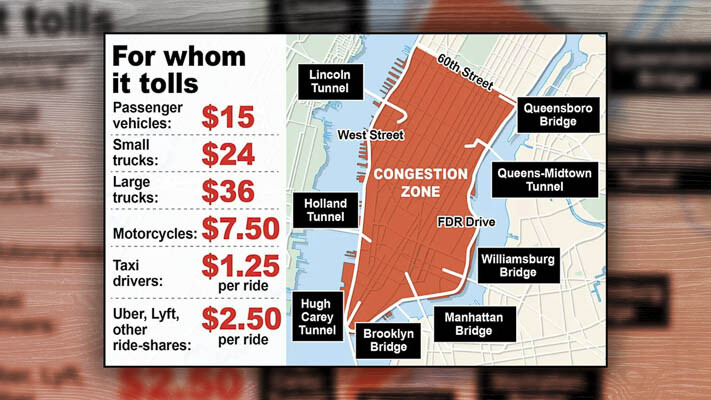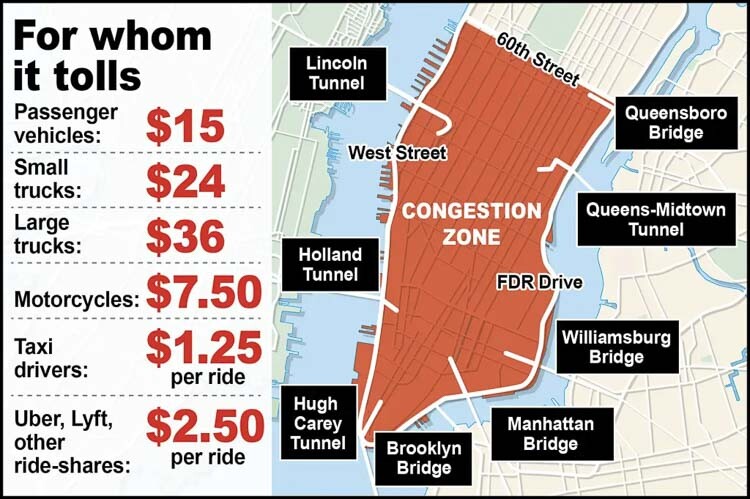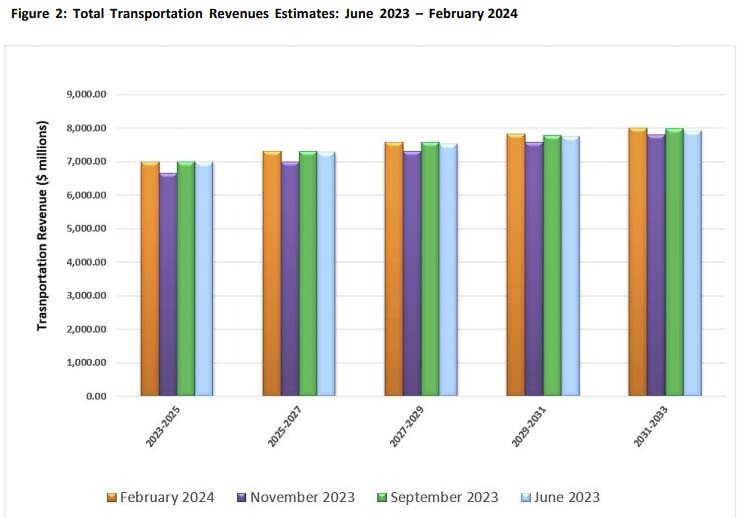
$15 charge to drive into zone will harm businesses and people
John Ley
for Clark County Today
The Metropolitan Transportation Authority (MTA) in New York has approved a “first in the nation” zone tolling program targeting midtown Manhattan. The dual goals of the program are to raise $1 billion per year to fund mass transit improvements while at the same time reducing traffic congestion.
“Don’t kill the goose that lays the egg,” Long Island board member David Mack told fellow board members. He was the only person to vote against the pricing plan.
The new $15 car tolls are slated to begin in June, but must get Federal Highway Administration (FHWA) approval. Additionally, numerous lawsuits are threatening to stop the high-priced tolls that will be devastating to a significant number of businesses. Union members, taxi and Lyft/Uber drivers were among vocal opponents protesting the new tax on entering the zone south of 60th Street in Manhattan. They labeled the MTA “Murdering the Taxis Agency” in their protest.
Mack expressed concerns about companies leaving the city, noting office vacancy rates in the aftermath of the pandemic lockdowns. New York Gov. Andrew Cuomo reversed his support of tolls, telling CBS News “now isn’t the time to make it more difficult for drivers coming to New York City.”

This serves as a cautionary tale for Portland and Southwest Washington area residents, as the city of Portland and many members of the Oregon legislature want to impose congestion pricing tolls for driving into the core of Portland. While Gov. Tina Kotek has paused implementation of the Regional Mobility Pricing Program (RMPP), she is asking the 2025 legislature to weigh in with a new transportation package that could include some form of tolling. Tolls remain part of the Interstate Bridge Replacement (IBR) financial plan.
Oregon’s HB 2017 allowed the Oregon Department of Transportation (ODOT) to study tolling “from the border” with Washington seven years ago. HB 3055 in 2021 allowed ODOT to proceed implementing tolling. They planned a “facility toll” to drive over a bridge, as well as “per mile” tolls. The “congestion pricing” would adjust charges based on the amount of traffic, with higher prices when there were more vehicles on the road.
A recent Oregon poll revealed 70 percent of Portland area residents oppose tolling. The more people learned about ODOT’s plans, the less they liked tolling. ODOT planned to spend $261 million simply to implement tolling on I-205.
Zone tolling is being considered as part of Portland’s Urban Mobility Strategy. KGW news recently reported tolling was “simultaneously alive and dead” until the Oregon legislature weighs in. Their report discusses tolling for US 26 and OR 217 in Washington County to address traffic gridlock on the westside.
In Washington, toll rates increased 50 percent on Seattle’s I-405/SR-167 earlier this month. The legislature has spent over $80 million to artificially lower tolls on the Tacoma Narrows Bridge, due to huge public pushback over rising toll prices.
The new tolls in NYC were approved by an 11-1 vote – despite backlash from critics who’ve slammed the plan as a cash grab that’ll saddle Big Apple drivers with yet another fee. There would be higher prices for trucks, and separate per trip charges for taxi and Uber/Lyft vehicles. But there were also carve outs for certain government vehicles including emergency response and school buses.
The current battle began with a 2019 law the New York legislature passed, allegedly demanding the MTA find a way to raise $1 billion a year to fund needed transportation improvements. A 4,000 page environmental impact assessment will serve as the basis for lawsuits trying to stop the tolls. Most of the ongoing cases have been consolidated in both Manhattan and Newark federal courts – with oral arguments set to take place in the Garden State case on April 3.
The infrastructure to collect tolls has already been installed on NYC streets. Here’s the breakdown for what each vehicle will be charged for once-a-day toll between 5 a.m. and 9 p.m. on weekdays and 9 a.m. and 9 p.m. on weekends:
- Passenger vehicles: $15
- Small trucks: $24
- Large trucks: $36
- Motorcycles: $7.50
- Taxi drivers: $1.25 per ride

ODOT & IBR funding holes
Here in the Portland metro area, ODOT faces an estimated $3 billion funding hole for multiple transportation projects that originated in HB 2017. The I-5 Rose Quarter project is now four times the initial $450 million price tag ODOT told the legislature. The I-205 Abernethy Bridge remains underfunded by several hundred million, and the 7 miles of new lanes between the bridge and Stafford Road have been canceled by ODOT. The I-5 Wilsonville Boone Bridge project remains completely unfunded.
Greg Johnson, administrator for the Interstate Bridge Replacement Program (IBR), has told the community the price tag will go up for replacing the Interstate Bridge. The original finance plan called for raising between $1.2 and $1.5 billion via bonding toll revenues. His staff will update the cost of the $5-$7.5 billion project later this summer. Some estimates indicate the price could go to $9 billion.
Oregon gas taxes continue to increase on a schedule set via HB 2017. That was a $5.3 billion tax increase in Oregon. The Washington legislature passed its “Move Ahead Washington” transportation package in 2022, raising $17 billion in taxes. It’s likely people will push back hard against additional transportation taxes to cover these funding shortfalls.
If the Washington and Oregon legislatures don’t raise gas, car tabs, and truck weight mile taxes, then legislators will likely look to tolling or some form of a “road usage charge” or RUC. But the gas tax is a road usage charge, where the more you drive, the more you pay at the pump.
The gas tax has the advantage of having only a 1 percent cost of collection. Tolling can have a 20 to 50 percent or more cost of collection. During the pandemic lockdowns, the Washington legislature bailed out the five state tolling systems with over a hundred million of general fund tax dollars.
Some point to the mandate for all electric cars in both states, not later than 2035. Yet the marketplace has shown very few people are actually buying electric vehicles, in spite of substantial tax breaks. In Washington, only 2 percent of registered vehicles are EVs. Oregon will likely fall short of a 250,000 EV goal in 2025.
It’s likely gas powered vehicles will continue to be the major form of private transportation for decades and continue to generate substantial money for state transportation projects. The Washington Office of Financial Management (OFM) projects total transportation revenues will increase by over $1 billion through 2033. Gas and fuel taxes comprise 48 percent of transportation revenues in the state. Car tabs and vehicle registration fees comprise another 29 percent.
Some citizens might suggest legislators look at trimming the scope of these projects to save valuable funds. The IBR could be broken into multiple phases, given the bridge is only $500 million. The I-5 Rose Quarter could have the legislature fund the “cap” over the freeway with general fund dollars, since creating expensive real estate isn’t the responsibility of the department of transportation.

Also read:
- Busy pavement season ahead on Vancouver streetsThe city of Vancouver is set to repave and preserve 76 lane miles across 20 neighborhoods in summer 2025, with ADA upgrades and community notices throughout.
- State representative: Expect sticker shock when Interstate Bridge project officials reveal price, tolling plansAt a town hall in Battle Ground, Rep. John Ley warned of major cost increases and tolling burdens tied to the Interstate Bridge replacement project.
- Opinion: Washington state lawmakers increase the cost of driving – againBob Pishue of Mountain States Policy Center argues that new vehicle and fuel taxes in Washington will raise driving costs while diverting funds away from roads.
- Overnight full closure of I-5 near Woodland for bridge inspection, May 6WSDOT will fully close southbound I-5 near Woodland overnight on Tuesday, May 6 for a bridge inspection using a chain drag test.
- Opinion: Do we still need TriMet?John A. Charles Jr. of the Cascade Policy Institute argues that TriMet should halt expansion plans and prepare for major service reductions in response to falling ridership and rising costs.









